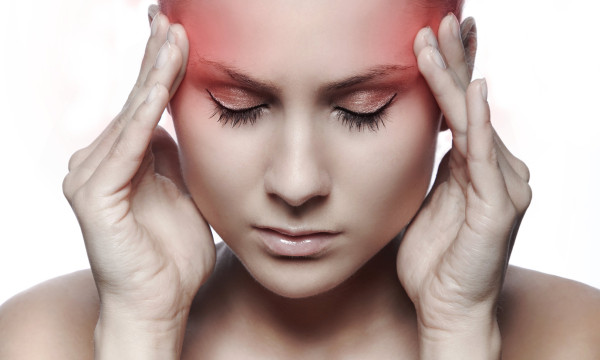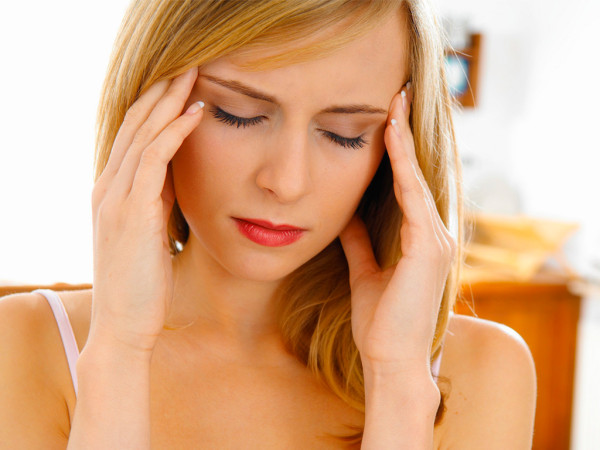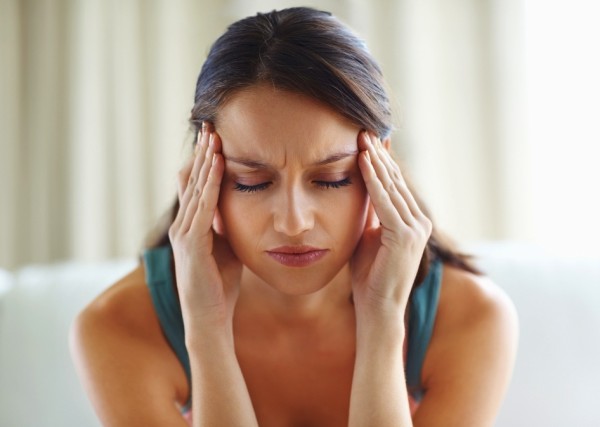Migraine: symptoms, treatment, causes
Headache is a problem of our time, but it is one thing when discomfort occurs occasionally, and quite another when it comes to migraines. What it is, how to distinguish between migraines and simple pain from fatigue, how to resist migraines and organize preventive measures - all this is about today.
Content
Migraine is a neurological disease. The degree of manifestation is different, as a rule, these are attacks that occur either several times a month, or a couple of times a year. The main manifestation of migraine is a severe headache, which can negatively affect the perception of light, sounds and bring the body to the point of nausea and vomiting.
If you have an unbearably severe headache and feel nauseous at the same time, then most likely you have a migraine.
Migraine symptoms
All the symptoms of migraine appear directly at the moments of attacks, which have four stages. It is worth noting that in the intervals between attacks, patients feel very well.
Precursors of migraine occur in more than half of patients. The prodrome period is an increased irritability, a feeling of fatigue and depression. The development of this symptomatology can manifest itself both in a few hours and a few days before the migraine itself. But given the individual characteristics of the body, it is important to note that in some people, on the contrary, symptoms can be expressed in increased activity, increased appetite, and some simply feel that "just about" will begin.
The next phase is the aura. Its presence is felt by only a third of patients, and it may not be felt with every attack. These are processes of reflecting what is happening in the brain. The duration of the symptom is about 10-30 minutes, but this, on average, may be longer. This is often a visual effect. For example, a person may “see” flashes of light, white spots, or zigzag lines of color that propagate to the periphery. Much less often, the symptom develops as a feeling of numbness and tingling in the fingers, which goes up the shoulder to the cheek or tongue on the same side. At the time of the onset of the aura, speech disorders and problems when trying to find words may be noted.
After this, the headache phase begins, it is this that is most difficult for patients. The duration of the pain lasts about two to three days. A headache that is caused by a migraine is usually severe. Often, only half of the head suffers, but the whole of it can hurt. Localization can also be vague, but most often it is the temporal or frontal parts. The nature of the pain is bursting and pulsating. It can intensify if physical activity takes place, the latter can also lead to nausea and vomiting. Irritants during this period are bright lights and loud sounds, as they aggravate the symptoms.
The last stage is the expansion phase. Here a person feels very tired, depressed and irritated, it is difficult for him to concentrate his attention on something. Symptoms can last for about a day. But then the patient again feels healthy and full of energy.
Migraine causes
There are a lot of reasons that can become migraine provocateurs, and they are all completely different. Let's consider the most common ones.
- Diets. But they are not the only ones. For some people, certain foods can trigger migraines, so it's important to keep track of your diet. This includes alcohol and skipping meals. Improper diet, complete withdrawal of caffeine, inadequate intake of water are also the culprits of headaches.
- Sleep. Any change in sleep patterns, whether constant sleep surplus or lack of sleep, negatively affects brain activity.
- Increased physical activity, long journeys, frequent change of time zones, flights by airplanes.
- Regular exposure to a bright shimmering color, strong and strong odors, a sharp change in weather conditions.
- Strong emotional stress and as a symptom of relaxation after severe stress.
- The hormonal factor, most often characteristic of women during menstruation, taking hormonal contraceptives, menopause, etc.
But the most common of all migraine causes is hunger. Try to eat in a measured way and not let yourself go hungry. Never skip breakfast, especially for children, because they can also get migraines.
Types of migraines
Let's consider the main types of migraines.
- Classic look. It has the “aura” syndrome that we talked about earlier.
- Normal view. A headache attack often begins without prior symptoms. She, in turn, is divided into components. They will be listed below.
- Abdominal migraine. Typical for children and adolescents. This type of disease is characterized by painful attacks in the abdominal region - abdominal cramps and headaches. At the time of an attack, the skin becomes pale and cold, nausea, diarrhea and vomiting may appear. Duration from half an hour to several days.
- Basilar view. More often observed in young girls and women. This can be expressed by short-term loss of consciousness, vomiting, lethargy and temporary loss of vision. Symptoms are similar to a tumor in the brain, meningitis and stroke, so these diseases must be excluded from the outset.
- Hemiplegic migraine. In terms of symptoms, it is similar to the previous type, but hemiplegia is still characteristic here - this is when the patient cannot move an arm or leg from any particular side.
- Ophthalmic view. The disease is characterized by pain in the eyes, or absolute paralysis of the muscles around the eyes. A wide variety of visual impairments can also occur: flashes of light, double vision, strabismus, etc. In this case, the attacks can be absolutely painless.
- Retinal appearance. Localization of pain occurs behind the eye, partial or complete loss of vision may also be noted. In some cases, the pain overtakes some of the halves of the head.
- Migraine status. The most difficult case is when severe headaches do not subside for three days, while it is almost impossible to relieve them. As a rule, all this is accompanied by repeated vomiting, which can lead to dehydration and bring a person to the hospital.
Migraine treatment
As sad as it may sound, no one has yet been able to completely cure migraines, and this despite the fact that the disease itself has been known since Ancient Egypt. But you can stop her attack. As soon as you understand that you have all the signs of a migraine and at the same time they regularly make themselves felt, you need to contact a specialist. According to statistics, only every sixth person seeks help from doctors, which is very bad. Such a careless attitude leads to the fact that the migraine transforms into a chronic stage, and the addiction to headache pills negatively affects the liver and other organs.
In the early stages of the manifestation of migraine, you can contact the local clinic, but in case of regular and often recurring pain, it is recommended to go for treatment to specialized centers, of which there are many in the country, the purpose of which is to treat the head.
Someone might think, why bother to treat a migraine if it goes away on its own. So, there is an explanation for this. If help does not come, or if it is not of high quality, then perturbations occur in the neurons of the central nervous system, which regularly accumulate and pain cells already spontaneously produce pain sensations. These are just those cases when the temporary passes into the chronic stage.
Below we give several options for treating migraines with alternative methods. But it is better to consult a doctor, and use traditional medicine only as a temporary means of salvation.
Cervical migraine
This is one of the varieties of migraine, which has many more names: "cervical syndrome", "vertebral artery syndrome", etc. But no matter how it is called, it is important that in any case we are talking about the same disease. Cervical migraine is a condition where blood flow to the brain is disrupted through several or one basins of the vertebral arteries.
From an anatomy lesson, everyone knows superficially that blood enters the brain through two basins. These are the carotid arteries (they supply up to 85% of the blood) and the vertebrates (they provide from 15 to 30% of the inflow and feed the back of the brain).
The defeat of the arteries is expressed in:
- dizziness;
- severe and very severe headaches;
- violations of visual and auditory functions;
- lack of coordination;
- loss of consciousness.
Thus, it turns out that with a cervical migraine, it may seem that the problem is in the head, because it is she who hurts, but in fact it is only a symptom. So, now it will be correct to understand the reasons that can cause such violations in the arteries.
- Lesions of a non-vertebral nature (i.e., something that is not associated with the spine). These are lesions that, as a rule, result from anomalies of a congenital nature, the development of atherosclerosis, the peculiarities of the location of the arteries and their size.
- Vertebral lesions (the development of pathologies that are characteristic of the spine). This includes all types of diseases of the spine, which in one way or another can serve as sources of the development of migraines. They are the most difficult to foresee, since even the "oldest" spinal injuries, which were received in adolescence and adolescence, can be a focus.
The aforementioned causes can compress and irritate the arteries, which inevitably leads to spasms. Blood circulation is impaired and the brain does not receive sufficient nutrition. The consequences of this, as a rule, are short-term and are activated at the moment of turning the head or changing the position of the body.
With cervical migraine, the localization of the headache often occurs in the occipital region. Irradiation can sometimes be observed, i.e. when the pain goes to the eye sockets, the bridge of the nose. Increased pain occurs at the moment the neck moves. The pain can be so severe that even brushing your hair makes it worse. When the head is tilted, a crunch is heard and a burning sensation is felt, and raising the head may be accompanied by dizziness.
Exactly as with ordinary migraine, visual and speech disorders are observed here. In some cases, there may be problems with swallowing, and the sensation of a foreign object in the throat. In especially advanced cases, turning the neck can turn into a fall of a person, while there is no loss of consciousness and he can immediately rise on his own. A variant is also possible with a short-term loss of consciousness, the patient turns off for 5-20 minutes. Upon regaining consciousness, he can stand up and move on his own, but for a long time he experiences a feeling of weakness.
How to relieve migraines
You can relieve migraines with medicines or using traditional medicine. And if everything is more or less clear with the latter, then with the first one must be extremely careful. Medical treatment is permissible only with the permission of a doctor. All pills have a large list of contraindications and many side effects that will add health problems to the existing headache.
Migraine pills
For mild pain: Analgin, Aspirin, Ibuprofen, Ketrolac, Paracetomol, Naproxen.
For intense and frequent pain: Migrenol, Tetralgin, Solpadein, Askofen, Kaffetin, Spazmalgon, Took.
For very severe headaches: Zomig, Relpax, Amigrenin, Rapimig, Naramig.
Do not self-assign - seek a prescription from a specialist.
Migraine - folk remedies
- Take one tablespoon of dry herbs and berries: calendula, hawthorn, motherwort, chamomile, knotweed and dried beet. Pour all this with a liter of boiling water and place in a thermos. Leave it on for 6 hours. Strain the mixture and add half a liter of vodka to it, leave for about a day. For an extra healing effect, you can add ginger. Drink 30 ml of composition every day three times. Duration of the course - until the finished drink ends.
- Soak the lemon zest a little in boiling water, or steam so that it is soft. After that, attach it to your temples, lie with it and rest for 15 minutes.
- Dissolve a couple of tablespoons of sugar in cold water, a sediment will remain at the bottom. Soak in this cheesecloth folded in several layers, apply to the forehead for 30 minutes.
- Peel a kilogram of potatoes, grate it and pour in a little milk to form a gruel. Let it brew for half an hour. After that, attach the composition to the place where the pain was localized, and wrap your head with something warm on top, you can just put on a hat. You need to walk with such a compress for at least an hour.
Prevention of migraine
Not all patients need preventive action. As a rule, these are people who are prone to its frequent occurrence, while the very appearance of a migraine entails third-party sores. So, you need to carry out prevention if:
- migraine makes itself felt more often than twice a month and at the same time attacks are very poorly tolerated by the body;
- for migraines, you take the appropriate medications more often twice a week;
- medications taken do not give the desired effect;
- you have contraindications that are indicated on your migraine medications;
- pain attacks provoke persistent neurological defects;
- migraine is a provocateur of epileptic seizures.
Now, the prevention of migraine by taking medications and dietary supplements prescribed by doctors has become very widespread. According to experts, they give a long-lasting and long-awaited effect.
And yet, try to remember under what circumstances do you experience pain attacks? Perhaps during this problem period you ate something wrong, maybe this was preceded by severe stress or a nervous environment? If it is possible to identify the provocateur, then you just need to try to avoid him as much as possible, this will greatly alleviate the condition.
In any case, a migraine is a reason to see a specialist. Firstly, only he will be able to determine the type of disease, which means he will be able to prescribe high-quality treatment and prevention. Secondly, under the guise of migraine, completely different diseases can be hidden, which are dangerous to health and life.







